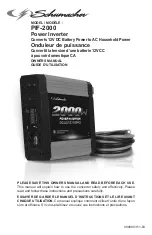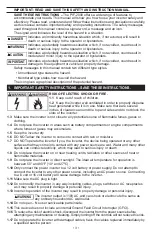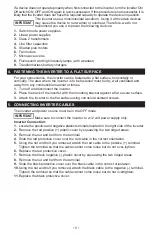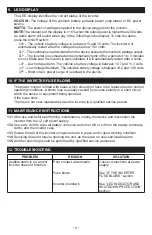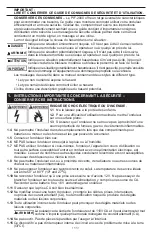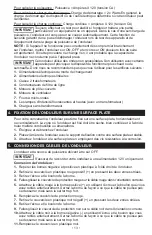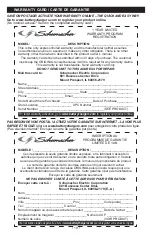
• 6 •
Connecting Inverter Cable to 12V Battery or 12V Power Source:
RISK OF CONTACT WITH BATTERY ACID.
BATTERY ACID IS A HIGHLY CORROSIVE
SULFURIC ACID.
A SPARK NEAR THE BATTERY MAY CAUSE A BATTERY EXPLOSION.
TO REDUCE THE RISK OF A SPARK NEAR THE BATTERY:
1.
Keep hands, hair, clothing and jewelry clear of battery terminals.
2.
Wear eye protection and clothing protection.
3.
For a negative-grounded vehicle, connect the POSITIVE (RED) terminal from
the inverter to the POSITIVE (POS, P, +) ungrounded post of the battery. Connect the
NEGATIVE (BLACK) terminal to the vehicle chassis or engine block away from the
battery. Do not connect the terminal to the carburetor, fuel lines or sheet-metal body
parts. Connect to a heavy gauge metal part of the frame or engine block.
4.
For a positive-grounded vehicle, connect the NEGATIVE (BLACK) terminal from the
inverter to the NEGATIVE (NEG, N, -) ungrounded post of the battery. Connect the
POSITIVE (RED) terminal to the vehicle chassis or engine block away from the battery.
Do not connect the terminal to the carburetor, fuel lines or sheet-metal body parts.
Connect to a heavy gauge metal part of the frame or engine block.
5.
To disconnect the inverter, reverse the above steps.
NOTE:
The internal speaker may make a brief “beep” when the inverter is being connected
to or disconnected from the 12 volt power source.
IMPORTANT
Failure to make the correct connections will result in blown fuses
and permanent damage to the inverter.
6. OPERATING INSTRUCTIONS
1.
Connect the inverter (see CONNECTING INVERTER CABLES section).
2.
Switch the inverter On/Off switch to the ON position.
3.
The LED indicator will light, verifying the inverter is receiving power.
4.
Switch the inverter On/Off switch to the OFF position. (The LED indicator may flash
briefly and/or the internal speaker may make a brief “beep”. This is normal.)
5.
Make sure the device to be operated is turned OFF.
6.
Plug the device into the inverter AC outlet or USB port.
7.
Switch the inverter On/Off switch to the ON position.
8.
Turn the device on.
9.
To disconnect, reverse the above procedure.
NOTE:
If more than one device is to be powered, start one device at a time to avoid
a power surge and overloading the inverter. The surge load of each device should not
exceed the inverter’s Continuous Operation wattage rate.
IMPORTANT
If there is a short circuit or power surge in the device,
Opp
will display and
the alarm will sound. Press the ON/OFF switch to turn off the alarm. If the
OPP
displays after several attempts, there is a short circuit or the device requires more
“starting” or “peak” load than the inverter is capable of providing.
IMPORTANT
If you are using the power inverter to operate a battery charger, monitor the
temperature of the battery charger for about 10 minutes. If the battery
charger becomes abnormally warm, disconnect it from the inverter immediately.
NOTE:
You can use an extension cord from the inverter to the device without significantly
decreasing the power being generated by the inverter. Use an 18 gauge (AWG) (0.75mm
2
)
extension cord. For best operating results, the extension cord should be no longer than 50
feet (15.2m).

